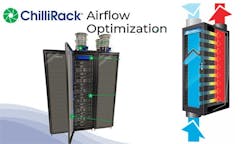ChilliRack Seeks to Slash Server Fan Energy, Boost Rack Utilization
David Klein clearly recalls when he decided to try and build a better cooling system. Klein had been in the data center industry for years, and in 2014 was visiting a facility in Northern Virginia.
“It was 105 outside in the middle of the summer, and in the building where I was working, the whole facility was being cooled to 45 degrees,” Klein said. “We were in shorts and T shirts outside and we had to bring our coats and sweatpants inside. I basically walked out thinking ‘our industry is completely nuts to cool a building like this.’
“I just thought it was not scalable in any way,” said Klein. “How do we solve this problem? I went back to my office, and I started hand-drawing racks and servers.”
The result is ChilliRack, a cooling system that Klein believes can address key challenges in the cost of cooling and the low utilization seen in many data centers. Klein has created a system that uses the empty space in the front and rear of the rack to create a pressurized plenum, offering greater control over the airflow within the rack. ChilliRack was unveiled last month with demos at a number of data center industry events.
“Our target is server fans,” said Klein, the CEO of ChilliRack, which is based in Herndon, Va. “We essentially duct the air from the data center to the equipment inside the rack. We drive server fans to their bare minimum, and we wipe out about 40% of the power usage.”
The company’s ChilliAire product can be used in existing racks, with slight modifications, in either a raised floor or overhead cooling environment. It effectively converts the rack into a containment system, with a solid front door and fan inputs in either the top or bottom of the rack, and the air removed via a chimney system at the top rear of the rack. The design allows the pressure and air flow to be tightly controlled, which in turn enables users to populate the rack with more servers.
Cooling Efficiency as a Utilization Strategy
After its lengthy road to market, ChilliRack arrives at an opportune moment, as power constraints and supply chain disruptions are creating uncertainties about delivery schedules for new data center capacity. As a result, data center operators and users will be increasingly focused on optimizing their available data center space and rack capacity.
“Twelve months ago, reducing power at a data center was a desire or a want,” said Klein. “In the last 12 months, it’s become a need or a must. I never thought I’d see a headline like Dominion Energy telling Loudoun County ‘we don’t have any more power for the next data center.””
After years of development and working with Black & Veatch on airflow simulations, ChilliRack began running its own production workloads on the ChilliAire system in April. Why has the technology taken such a deliberate path to market?
“Credibility,” said Klein. “It’s the number one thing you need for a product to succeed in this market. You have to have 5 nines (99.999% reliability). We designed every component in the system to be fully redundant in every way possible, and we’re now at a point where it’s tested and ready.”
How ChilliRack Works
ChilliRack is the latest effort to target the energy use of server fans, which have long been recognized as a major contributor to IT power bills. Hyperscale operators began targeting fan energy about a decade ago. In 2011, Facebook began working with Intel to modulate the speed of server fans to work with lower airflow. At about the same time, Microsoft adopted a highly-efficient IT-PAC data module that used precise airflow control to eliminate server fans.
Pressure and airflow are required to keep cool air moving across server components inside a rack. The ChilliRack design effectively shifts the fan activity, using an efficient rack-level fan instead of smaller fans on each server fans. The design uses a redundant fan system at either the top or bottom of the rack to deliver cool air into a channel in the front of the servers, while using a solid, transparent front door to create an enclosed air plenum.
“There are void spaces in the rack that can be used for internal ducting,” said Klein. “It’s usually about three inches on either side. And then we have the front and the back as well.”
Here’s a diagram of the design from a recent ChilliRack presentation:
ChilliRack has been awarded 33 awarded patents in 16 countries for its cooling system, according to Klein, who said the system has been operational and running ChilliRack’s corporate IT at a Cyxtera data center since April.
“Our data shows that we essentially drive server fans to their bare minimum,” said Klein. “When we talk about ROI (return on investment) and what the customer gains, there are two things that we can quantify clearly. Number one, we’re going to drive down your power use. The second point that’s crucial is that we’re populating our racks fully.”
The ability to pack servers into racks can alter the economics of a user’s IT capacity. Klein believes this strategy is of particular value to companies with limited rack space, who can create additional capacity by populating their racks more fully. He says ChilliRack is also working with colocation providers, who can improve their profitability with more efficient use of power and space.
ChilliRack says it can support racks with up to 18kW of power capacity, about double the current average for rack power density.
About the Author



